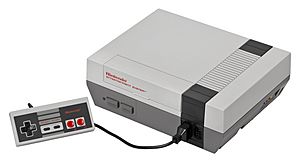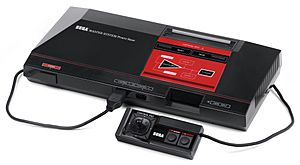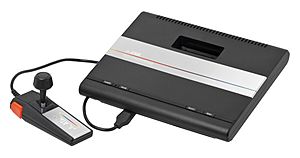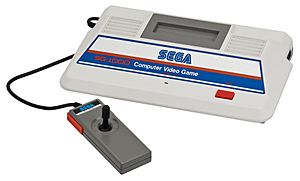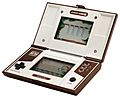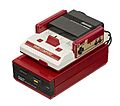History of video game consoles (third generation) facts for kids
The third generation of video game consoles was a super important time for gaming! It started on July 15, 1983, with the launch of the Nintendo Entertainment System (NES), also known as the Famicom in Japan, and the Sega SG-1000. This period helped fix a big problem in the video game world called the video crash of 1983 that happened in North America. Because of this, Japan became the main leader in home video games. During this time, games also got better graphics, moving from simple single-screen views to cool scrolling backgrounds.
The NES/Famicom was the most popular console of this generation. It sold more than any other system, followed by the Sega Master System and the Atari 7800. The NES stayed the top-selling home console until the PlayStation came out in 1996! Many consoles from this time used 8-bit processors, which are like the brains of the console. Later, some systems like the Mega Drive/Genesis used even more powerful 16-bit processors. The NES/Famicom was especially popular in the United States.
Contents
Awesome Home Consoles
This generation brought many exciting home consoles into living rooms around the world. Let's look at some of the most famous ones!
Nintendo Entertainment System (NES)
The NES, or Famicom in Japan, was a huge hit! It was made by Nintendo and launched in Japan on July 15, 1983. It came to the United States in October 1985. The NES used game cartridges and even floppy disks in Japan. It had many popular games, like Super Mario Bros. and Super Mario Bros. 3. People loved accessories like the NES Zapper (a light gun) and the Mattel Power Glove. The NES used a Ricoh 2A03 processor and had 2 KB of main memory. Its graphics showed 256x240 pixels with 25 colors at once.
Sega Master System
The Sega Master System was made by Sega and first came out in Japan on October 20, 1985. It arrived in the United States in June 1986. This console also used cartridges and special data cards for games. It could even play games from the older Sega SG-1000 system in Japan! Some popular games included Hang-On and Safari Hunt. The Master System had cool accessories like the Light Phaser and Sega 3-D Glasses. It used a NEC 780C processor and had 8 KB of main memory. Its graphics were 256x240 pixels with 32 colors at once.
Atari 7800
The Atari 7800 was made by Atari and launched in the United States in June 1986. A neat thing about the Atari 7800 was that it could play games from the older Atari 2600 console! This meant you could play your old favorites on a new system. A popular game that came with the console was Pole Position II. The Atari 7800 used a special 6502C processor and had 4 KB of main memory. Its graphics were 320x200 pixels with 25 colors at once.
SG-1000
The SG-1000 was also made by Sega and was released in Japan on July 15, 1983, the same day as the Famicom! It used both cartridges and cassette tapes for games. It had a 780C processor and 2 KB of main memory. Its graphics were 256x192 pixels with 16 colors.
How Many Consoles Were Sold?
It's fun to see which consoles sold the most! Here's a quick look at how many units were sold worldwide for some of the top consoles:
| Console | Units sold worldwide | Japan | Americas | Elsewhere |
|---|---|---|---|---|
| Nintendo Entertainment System | 61.91 million (as of December 2009) | 19.35 million (December 2009) | 34 million (December 2009) | 8.56 million (December 2009) |
| Sega Master System | 11.8 million | 1 million (1986) | United States: 2 million (1992) Brazil: 5 million (2012) |
Western Europe: 6.8 million (1993) |
| Atari 7800 | 3.77 million (December 1990) | Unknown | United States: 2 million (June 1988) | Unknown |
Cool Handheld Systems
Even back then, people loved gaming on the go!
Nintendo Game & Watch
Nintendo's Game & Watch handhelds were super popular during this generation. These small devices had a screen and usually one game. They were a big hit and kept selling well until 1991.
-
Nintendo Game & Watch (Released 1980-1991)
Popular Games from This Era
Many classic games that are still loved today first appeared in the third generation! Here are some of the most famous ones:
- Super Mario Bros.
- The Legend of Zelda
- Dragon Quest
- Final Fantasy
- Mega Man 2
- Metal Gear
Images for kids
-
Family Computer Disk System (1986)
-
VTech Socrates (1988)
-
Amstrad GX4000 (1990)
-
Commodore 64 Games System (1990)
See also
 In Spanish: Videoconsolas de tercera generación para niños
In Spanish: Videoconsolas de tercera generación para niños


